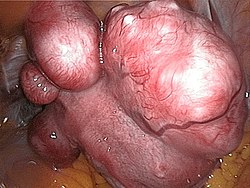Myoma

Editor-In-Chief: Prab R Tumpati, MD
Obesity, Sleep & Internal medicine
Founder, WikiMD Wellnesspedia &
W8MD medical weight loss NYC and sleep center NYC
| Myoma | |
|---|---|

| |
| Synonyms | Uterine fibroid, leiomyoma, fibromyoma |
| Pronounce | N/A |
| Specialty | N/A |
| Symptoms | Abnormal uterine bleeding, pelvic pain, frequent urination, constipation, infertility |
| Complications | Anemia, urinary tract infections, pregnancy complications |
| Onset | Reproductive age |
| Duration | Chronic |
| Types | N/A |
| Causes | Genetic factors, hormonal factors |
| Risks | Obesity, family history, nulliparity, early menarche |
| Diagnosis | Pelvic examination, ultrasound, MRI |
| Differential diagnosis | Adenomyosis, endometrial cancer, ovarian cysts |
| Prevention | N/A |
| Treatment | Medication, surgery, uterine artery embolization, MRI-guided focused ultrasound |
| Medication | GnRH agonists, oral contraceptives, NSAIDs |
| Prognosis | N/A |
| Frequency | Common in women of reproductive age |
| Deaths | N/A |




Myoma is a type of benign tumor that develops from muscle tissue. The most common type of myoma is the uterine fibroid, which grows in the muscle tissue of the uterus. Other types of myomas can grow in other muscle tissues, such as the heart or esophagus.
Types of Myoma[edit]
There are several types of myomas, including:
- Uterine fibroids: These are the most common type of myoma. They grow in the muscle tissue of the uterus and can cause symptoms such as heavy menstrual bleeding, pelvic pain, and infertility.
- Leiomyoma: This is a type of myoma that can grow in any smooth muscle tissue, including the uterus, stomach, and esophagus.
- Rhabdomyoma: This is a rare type of myoma that grows in skeletal muscle tissue. It is most commonly found in the heart.
Symptoms[edit]
The symptoms of a myoma can vary depending on its size and location. Some people with myomas have no symptoms, while others may experience:
Treatment[edit]
Treatment for myomas depends on the size and location of the myoma, as well as the patient's symptoms and overall health. Options may include:
- Medication: Certain medications can help to shrink myomas or relieve symptoms.
- Surgery: In some cases, surgery may be needed to remove the myoma.
- Uterine artery embolization: This is a minimally invasive procedure that can be used to shrink myomas by cutting off their blood supply.
Gallery of Gynecological Illustrations[edit]
- A curated collection of gynecological images from historical and medical sources.
-
Illustration of a woman with uterine fibroids.
-
Medical illustration showing the locations of fibroids within the uterus.
-
Photograph of a giant uterine fibroid removed during surgery.
-
A large uterine fibroid, documented in the Wellcome Collection.
-
Histological image of leiomyomata in the uterus.
-
Surgical procedure of myomectomy for removing uterine fibroids.
-
Illustration from the "Pathology and Treatment of Diseases of Women" (1912), detailing fibroid pathology.
-
Illustration comparing the uterus before and after a myomectomy procedure.
See Also[edit]
External links[edit]
Ad. Transform your life with W8MD's Budget GLP-1 injections from $75


W8MD offers a medical weight loss program to lose weight in Philadelphia. Our physician-supervised medical weight loss provides:
- Weight loss injections in NYC (generic and brand names):
- Zepbound / Mounjaro, Wegovy / Ozempic, Saxenda
- Most insurances accepted or discounted self-pay rates. We will obtain insurance prior authorizations if needed.
- Generic GLP1 weight loss injections from $75 for the starting dose.
- Also offer prescription weight loss medications including Phentermine, Qsymia, Diethylpropion, Contrave etc.
NYC weight loss doctor appointmentsNYC weight loss doctor appointments
Start your NYC weight loss journey today at our NYC medical weight loss and Philadelphia medical weight loss clinics.
- Call 718-946-5500 to lose weight in NYC or for medical weight loss in Philadelphia 215-676-2334.
- Tags:NYC medical weight loss, Philadelphia lose weight Zepbound NYC, Budget GLP1 weight loss injections, Wegovy Philadelphia, Wegovy NYC, Philadelphia medical weight loss, Brookly weight loss and Wegovy NYC
|
WikiMD's Wellness Encyclopedia |
| Let Food Be Thy Medicine Medicine Thy Food - Hippocrates |
Medical Disclaimer: WikiMD is not a substitute for professional medical advice. The information on WikiMD is provided as an information resource only, may be incorrect, outdated or misleading, and is not to be used or relied on for any diagnostic or treatment purposes. Please consult your health care provider before making any healthcare decisions or for guidance about a specific medical condition. WikiMD expressly disclaims responsibility, and shall have no liability, for any damages, loss, injury, or liability whatsoever suffered as a result of your reliance on the information contained in this site. By visiting this site you agree to the foregoing terms and conditions, which may from time to time be changed or supplemented by WikiMD. If you do not agree to the foregoing terms and conditions, you should not enter or use this site. See full disclaimer.
Credits:Most images are courtesy of Wikimedia commons, and templates, categories Wikipedia, licensed under CC BY SA or similar.
Translate this page: - East Asian
中文,
日本,
한국어,
South Asian
हिन्दी,
தமிழ்,
తెలుగు,
Urdu,
ಕನ್ನಡ,
Southeast Asian
Indonesian,
Vietnamese,
Thai,
မြန်မာဘာသာ,
বাংলা
European
español,
Deutsch,
français,
Greek,
português do Brasil,
polski,
română,
русский,
Nederlands,
norsk,
svenska,
suomi,
Italian
Middle Eastern & African
عربى,
Turkish,
Persian,
Hebrew,
Afrikaans,
isiZulu,
Kiswahili,
Other
Bulgarian,
Hungarian,
Czech,
Swedish,
മലയാളം,
मराठी,
ਪੰਜਾਬੀ,
ગુજરાતી,
Portuguese,
Ukrainian








